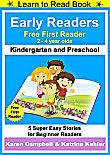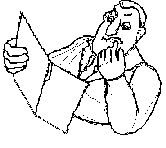
Kindergarten and Preschool: 5 Super Easy Stories for Beginner Readers

| Book of the Month | ||
 |
Early Readers First Learn to Read Book Kindergarten and Preschool: 5 Super Easy Stories for Beginner Readers |
 |
Publisher: KC Global Enterprises
Authors: Karen Campbell and Katrina Kahler
Free on Kindle
ASIN: B00JUYKDSQ
Two English sayings come to mind as one opens this book. The first is that 'There is no such thing as a free lunch', and the second says 'You get what you pay for'. So what is one to make of a child's reader that is free for the price of an internet download? The authors of the book claim that they have taught 'hundreds of children to read', which, given modern class sizes, can actually be achieved with a few years of kindergarten teaching. This is not a 'learn to read' book which teaches phonics or reading aloud. This book has the very basic aim of showing very young children that written words have meaning. It very definitely needs an adult helping the child every step along the way. And it teaches vocabulary as much as reading.
The book has five 'stories' in 176 pages. These are not actually stories, but rather thematic vocabulary sets without anything resembling characters or a plot. So At the Zoo introduces animals from A-Z, using what are clearly free clipart pictures in a great variety of styles. (If you want pictures in a consistent style, you will need a book where the publisher paid for an artist - and that book will not be free.) In a nice touch, the 'quiz' pictures which ask what the animals are all have the animals shown in consistently styled photographs. This helps the child to realize that the words and pictures refer to types of animals in general and not to a particular clip-art drawing. It would have been good to use the same animals again in the I can count 'story' which teaches numbers 1-10. Also, it is up to the adult to explain why numbers are identified by words and by numerals.
Every page consists of a picture, and/or up to a dozen words - but usually fewer. The words are in a small font, so be prepared to use your Kindle's magnifier. The How do you Feel? 'story' shows different people and animals expressing different emotions. For example 'relaxed' shows a cartoon frog lying back. At this point a proper textbook would tell the adult how to explain that 'relaxed' does not mean 'frog', just as 'happy' earlier does not mean 'smiling boy on a bicycle'. However, 'free' means 'you get what you pay for', and if you can figure out for yourself how to explain to a child that the pictures depict feelings, then the book is a useful way to introduce the words for these feelings.
Who is this book for? If you are an parent wanting to prepare your child for pre-school then this book is not all you will need to teach reading. It is however a good teaching aid that you can use to demonstrate that there are other ways to show something than speech and pictures. How you use the book is very much up to you. However, children are very uncritical of things like different art styles and the book presents very straightforward challenges which suit the subject audience. Given a good instructor, young children will be more prepared to overlook the book's obvious deficiencies than a more discerning adult. Overall, it represents good value for money.
Verdict: A useful, though somewhat flawed, reader
Assessment 5/10